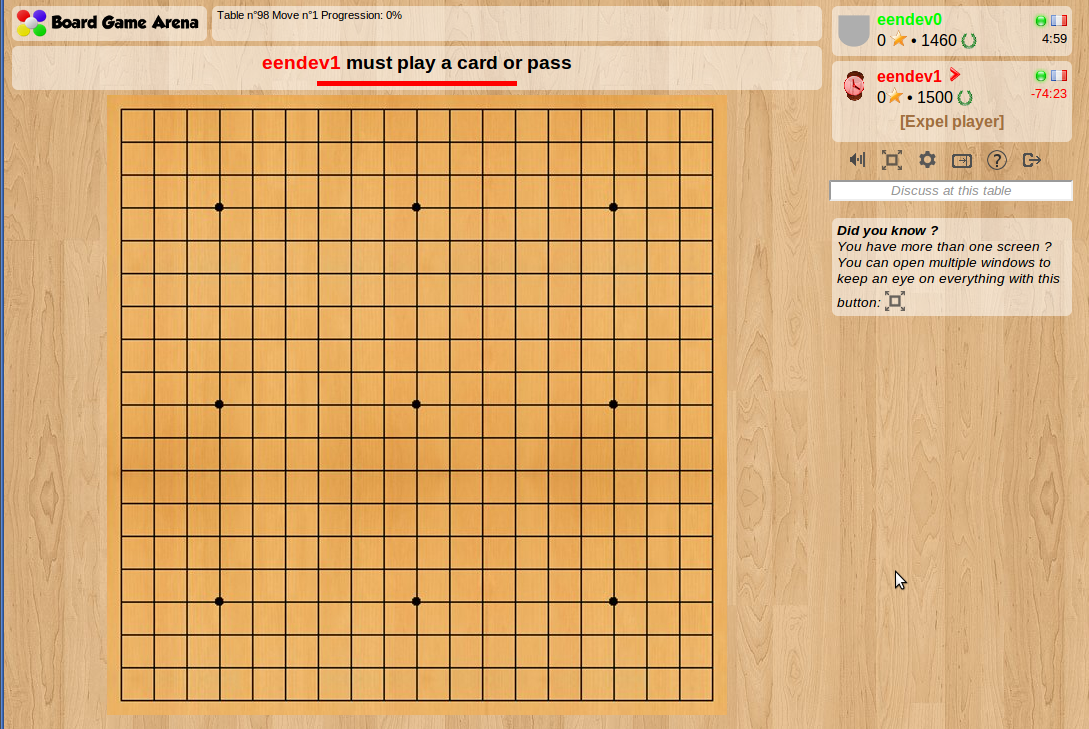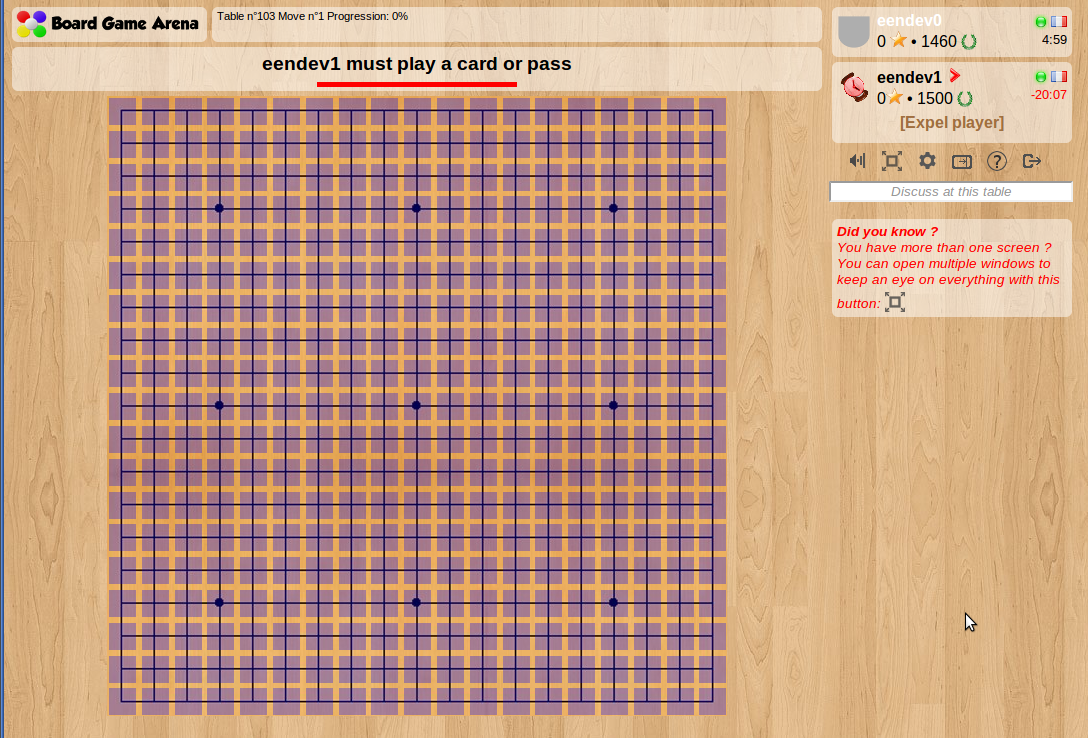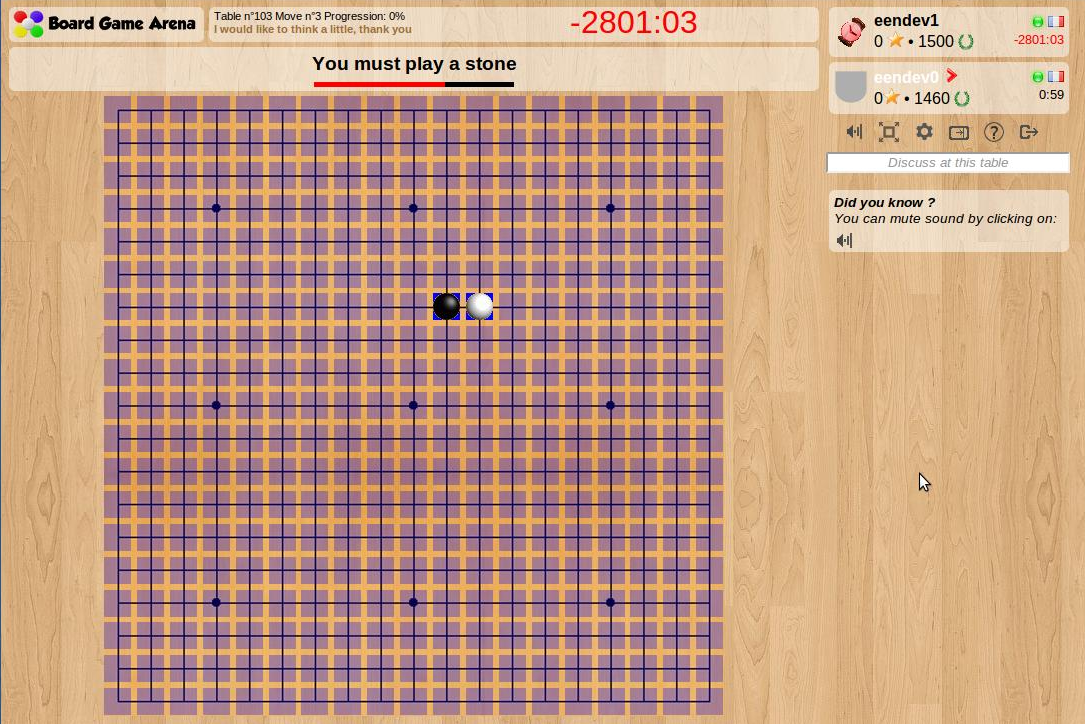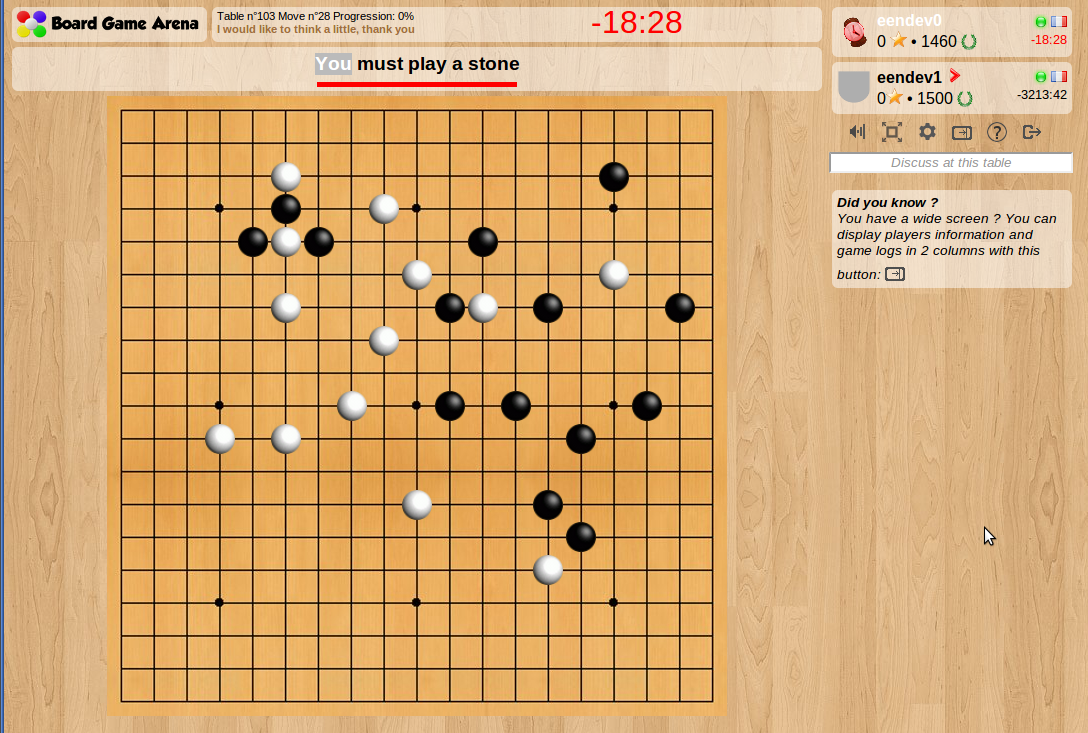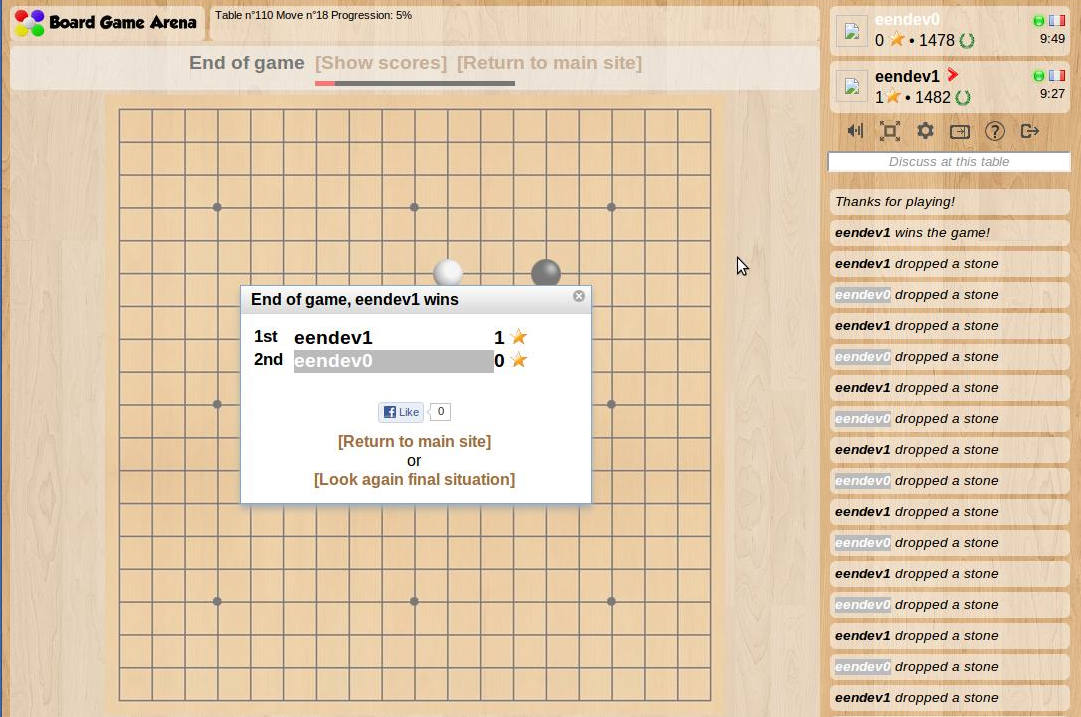This is a documentation for Board Game Arena: play board games online !
Tutorial gomoku: Atšķirības starp versijām
| 394. rindiņa: | 394. rindiņa: | ||
</pre> | </pre> | ||
These styles rely on an PNG image (with transparent background) of both the white and black stones, and positions the background appropriately to show only the part of the background image matching the appropriate stone (or the transparent space if there is no stone). Here is what the image looks like | These styles rely on an PNG image (with transparent background) of both the white and black stones, and positions the background appropriately to show only the part of the background image matching the appropriate stone (or the transparent space if there is no stone). Here is what the image looks like: | ||
[[File:Gomoku stones.png]] | [[File:Gomoku stones.png]] | ||
The red circle is used to highlight intersections where you can drop a stone when the player's cursor hovers over them (we also change the cursor to a hand). To do this: | |||
* we define in the css file the 'clickable' css class | |||
<pre> | |||
.clickable { | |||
cursor: pointer; | |||
} | |||
.clickable:hover { background-position: -90px 0px; } | |||
</pre> | |||
* in gomoku.js, when we enter the 'playerTurn' state, we add the 'clickable' style to the intersections where there is no stone | |||
<pre> | |||
onEnteringState: function( stateName, args ) | |||
{ | |||
console.log( 'Entering state: '+stateName ); | |||
switch( stateName ) | |||
{ | |||
case 'playerTurn': | |||
if( this.isCurrentPlayerActive() ) | |||
{ | |||
var queueEntries = dojo.query( '.no_stone' ); | |||
for(var i=0; i<queueEntries.length; i++) { | |||
dojo.addClass( queueEntries[i], 'clickable' ); | |||
} | |||
} | |||
} | |||
}, | |||
</pre> | |||
The basic game turn is implemented: you can now drop some stones! | The basic game turn is implemented: you can now drop some stones! | ||
Versija, kas saglabāta 2012. gada 5. decembris, plkst. 23.55
This tutorial will guide you through the basics of creating a simple game on BGA Studio, through the example of Gomoku (also known as Gobang or Five in a Row).
You will start from our 'emtpy game' template
Here is how your games looks by default when it has just been created :
Setup the board
Gather useful images for the game and edit them as needed. Upload them in the 'img' folder of your SFTP access.
Edit .tpl to add some divs for the board in the HTML.
<div id="gmk_game_area"> <div id="gmk_background"> <div id="gmk_goban"> </div> </div> </div>
Edit .css to set the div sizes and positions and show the image of the board as background.
#gmk_game_area {
text-align: center;
position: relative;
}
#gmk_background {
width: 620px;
height: 620px;
position: relative;
display: inline-block;
}
#gmk_goban {
background-image: url( '../../img/gomoku/goban.jpg');
width: 620px;
height: 620px;
position: absolute;
}
Setup the backbone of your game
Edit dbmodel.sql to create a table for intersections. We need coordinates for each intersection and a field to store the color of the stone on this intersection (if any).
CREATE TABLE IF NOT EXISTS `intersection` ( `id` int(10) unsigned NOT NULL AUTO_INCREMENT, `coord_x` tinyint(2) unsigned NOT NULL, `coord_y` tinyint(2) unsigned NOT NULL, `stone_color` varchar(8) NULL, PRIMARY KEY (`id`) ) ENGINE=InnoDB DEFAULT CHARSET=utf8 AUTO_INCREMENT=1 ;
Edit gomoku.game.php->setupNewGame() to insert the empty intersections (19x19) with coordinates into the database.
// Insert (empty) intersections into database
$sql = "INSERT INTO intersection (coord_x, coord_y) VALUES ";
$values = array();
for ($x = 0; $x < 19; $x++) {
for ($y = 0; $y < 19; $y++) {
$values[] = "($x, $y)";
}
}
$sql .= implode( $values, ',' );
self::DbQuery( $sql );
Edit gomoku.game.php->getAllDatas() to retrieve the state of the intersections from the database.
// Intersections
$sql = "SELECT id, coord_x, coord_y, stone_color FROM intersection ";
$result['intersections'] = self::getCollectionFromDb( $sql );
Edit .tpl to create a template for intersections (jstpl_intersection).
var jstpl_intersection='<div class="gmk_intersection ${stone_type}" id="intersection_${x}_${y}"></div>';
Define the styles for the intersection divs
.gmk_intersection {
width: 30px;
height: 30px;
position: relative;
}
Edit gomoku.js->setup() to setup the intersections layer that will be used to get click events and to display the stones. The data you returned in $result['intersections'] in gomoku.game.php->getAllDatas() is now available in your gomoku.js->setup() in gamedatas.intersections.
// Setup intersections
for( var id in gamedatas.intersections )
{
var intersection = gamedatas.intersections[id];
dojo.place( this.format_block('jstpl_intersection', {
x:intersection.coord_x,
y:intersection.coord_y,
stone_type:(intersection.stone_color == null ? "no_stone" : 'stone_' + intersection.stone_color)
} ), $ ( 'gmk_background' ) );
var x_pix = this.getXPixelCoordinates(intersection.coord_x);
var y_pix = this.getYPixelCoordinates(intersection.coord_y);
this.slideToObjectPos( $('intersection_'+intersection.coord_x+'_'+intersection.coord_y), $('gmk_background'), x_pix, y_pix, 10 ).play();
if (intersection.stone_color != null) {
// This intersection is taken, it shouldn't appear as clickable anymore
dojo.removeClass( 'intersection_' + intersection.coord_x + '_' + intersection.coord_y, 'clickable' );
}
}
Use some temporary css border-color or background-color and opacity to see the divs and make sure you have them positioned right.
.gmk_intersection {
width: 30px;
height: 30px;
position: relative;
background-color: blue;
opacity: 0.3;
}
You can declare some constants in material.inc.php and pass them to your gomoku.js for easy repositioning (modify constant, refresh). This is especially useful if the same constants have to be used on the server and on the client.
- Declare your constants in material.inc.php (this will be automatically included in your gomoku.game.php)
$this->gameConstants = array( "INTERSECTION_WIDTH" => 30, "INTERSECTION_HEIGHT" => 30, "INTERSECTION_X_SPACER" => 2.8, // Float "INTERSECTION_Y_SPACER" => 2.8, // Float "X_ORIGIN" => 0, "Y_ORIGIN" => 0, );
- In gomoku.game.php->getAllDatas(), add the constants to the result array
// Constants
$result['constants'] = $this->gameConstants;
- In gomoku.js constructor, define a class variable for constants
// Game constants
this.gameConstants = null;
- Then use it in your getXPixelCoordinates and getYPixelCoordinates functions
getXPixelCoordinates: function( intersection_x )
{
return this.gameConstants['X_ORIGIN'] + intersection_x * (this.gameConstants['INTERSECTION_WIDTH'] + this.gameConstants['INTERSECTION_X_SPACER']);
},
getYPixelCoordinates: function( intersection_y )
{
return this.gameConstants['Y_ORIGIN'] + intersection_y * (this.gameConstants['INTERSECTION_HEIGHT'] + this.gameConstants['INTERSECTION_Y_SPACER']);
},
Here is what you should get:
Manage states and events
Define your game states in states.inc.php. For gomoku we will use 3 states. One to play, one to check the end game condition, one to give his turn to the other player if the game is not over.
The first state requires an action from the player, so its type is 'activeplayer'.
The two others are automatic actions for the game, so their type is 'game'.
We will update the progression while checking for the end of the game, so for this state we set the 'updateGameProgression' flag to true.
2 => array(
"name" => "playerTurn",
"description" => clienttranslate('${actplayer} must play a stone'),
"descriptionmyturn" => clienttranslate('${you} must play a stone'),
"type" => "activeplayer",
"possibleactions" => array( "playStone" ),
"transitions" => array( "stonePlayed" => 3, "zombiePass" => 3 )
),
3 => array(
"name" => "checkEndOfGame",
"description" => '',
"type" => "game",
"action" => "stCheckEndOfGame",
"updateGameProgression" => true,
"transitions" => array( "gameEnded" => 99, "notEndedYet" => 4 )
),
4 => array(
"name" => "nextPlayer",
"description" => '',
"type" => "game",
"action" => "stNextPlayer",
"transitions" => array( "" => 2 )
),
Add onclick events on intersections in gomoku.js->setup()
// Add events on active elements (the third parameter is the method that will be called when the event defined by the second parameter happens - this method must be declared beforehand)
this.addEventToClass( "gmk_intersection", "onclick", "onClickIntersection");
Declare the corresponding gomoku.js->onClickIntersection() function, which calls an action function on the server with appropriate parameters
onClickIntersection: function( evt )
{
console.log( '$$$$ Event : onClickIntersection' );
dojo.stopEvent( evt );
if( ! this.checkAction( 'playStone' ) )
{ return; }
var node = evt.currentTarget.id;
var coord_x = node.split('_')[1];
var coord_y = node.split('_')[2];
console.log( '$$$$ Selected intersection : (' + coord_x + ', ' + coord_y + ')' );
if ( this.isCurrentPlayerActive() ) {
this.ajaxcall( "/gomoku/gomoku/playStone.html", { lock: true, coord_x: coord_x, coord_y: coord_y }, this, function( result ) {}, function( is_error ) {} );
}
},
Add this action function in gomoku.action.php, retrieving parameters and calling the appropriate game action
public function playStone()
{
self::setAjaxMode();
// Retrieve arguments
// Note: these arguments correspond to what has been sent through the javascript "ajaxcall" method
$coord_x = self::getArg( "coord_x", AT_posint, true );
$coord_y = self::getArg( "coord_y", AT_posint, true );
// Then, call the appropriate method in your game logic, like "playCard" or "myAction"
$this->game->playStone( $coord_x, $coord_y );
self::ajaxResponse( );
}
Add game action in gomoku.game.php to update the database, send a notification to the client providing the event notified (‘stonePlayed’) and its parameters, and proceed to the next state.
function playStone( $coord_x, $coord_y )
{
// Check that this is player's turn and that it is a "possible action" at this game state (see states.inc.php)
self::checkAction( 'playStone' );
$player_id = self::getActivePlayerId();
// Check that this intersection is free
$sql = "SELECT
id, coord_x, coord_y, stone_color
FROM
intersection
WHERE
coord_x = $coord_x
AND coord_y = $coord_y
AND stone_color is null
";
$intersection = self::getObjectFromDb( $sql );
if ($intersection == null) {
throw new BgaUserException( self::_("There is already a stone on this intersection, you can't play there") );
}
// Get player color
$sql = "SELECT
player_id, player_color
FROM
player
WHERE
player_id = $player_id
";
$player = self::getNonEmptyObjectFromDb( $sql );
$color = ($player['player_color'] == 'ffffff' ? 'white' : 'black');
// Update the intersection with a stone of the appropriate color
$intersection_id = $intersection['id'];
$sql = "UPDATE
intersection
SET
stone_color = '$color'
WHERE
id = $intersection_id
";
self::DbQuery($sql);
// Notify all players
self::notifyAllPlayers( "stonePlayed", clienttranslate( '${player_name} dropped a stone ${coordinates}' ), array(
'player_id' => $player_id,
'player_name' => self::getActivePlayerName(),
'coordinates' => $this->getFormattedCoordinates($coord_x, $coord_y),
'coord_x' => $coord_x,
'coord_y' => $coord_y,
'color' => $color
) );
// Go to next game state
$this->gamestate->nextState( "stonePlayed" );
}
Catch the notification in gomoku.js->setupNotifications() and link it to a javascript function to execute when the notification is received.
setupNotifications: function()
{
console.log( 'notifications subscriptions setup' );
dojo.subscribe( 'stonePlayed', this, "notif_stonePlayed" );
}
Implement this function in javascript to update the intersection to show the stone, and register it inside the setNotifications function.
notif_stonePlayed: function( notif )
{
console.log( '**** Notification : stonePlayed' );
console.log( notif );
// Create a stone
dojo.place( this.format_block('jstpl_stone', {
stone_type:'stone_' + notif.args.color,
x:notif.args.coord_x,
y:notif.args.coord_y
} ), $( 'intersection_' + notif.args.coord_x + '_' + notif.args.coord_y ) );
// Place it on the player panel
this.placeOnObject( $( 'stone_' + notif.args.coord_x + '_' + notif.args.coord_y ), $( 'player_board_' + notif.args.player_id ) );
// Animate a slide from the player panel to the intersection
dojo.style( 'stone_' + notif.args.coord_x + '_' + notif.args.coord_y, 'zIndex', 1000 );
var slide = this.slideToObject( $( 'stone_' + notif.args.coord_x + '_' + notif.args.coord_y ), $( 'intersection_' + notif.args.coord_x + '_' + notif.args.coord_y ), 1000 );
dojo.connect( slide, 'onEnd', this, dojo.hitch( this, function() {
dojo.style( 'stone_' + notif.args.coord_x + '_' + notif.args.coord_y, 'zIndex', 'auto' );
}));
slide.play();
// This intersection is taken, it shouldn't appear as clickable anymore
dojo.removeClass( 'intersection_' + notif.args.coord_x + '_' + notif.args.coord_y, 'clickable' );
},
For this function to work properly, you also need:
- to declare a stone javascript template in your .tpl file.
var jstpl_stone='<div class="gmk_stone ${stone_type}" id="stone_${x}_${y}"></div>';
- to define the css styles for the stones
.gmk_stone {
width: 30px;
height: 30px;
position: absolute;
background-image: url( '../../img/gomoku/stones.png');
}
.no_stone { background-position: -60px 0px; }
.stone_black { background-position: 0px 0px; }
.stone_white { background-position: -30px 0px; }
These styles rely on an PNG image (with transparent background) of both the white and black stones, and positions the background appropriately to show only the part of the background image matching the appropriate stone (or the transparent space if there is no stone). Here is what the image looks like:
The red circle is used to highlight intersections where you can drop a stone when the player's cursor hovers over them (we also change the cursor to a hand). To do this:
- we define in the css file the 'clickable' css class
.clickable {
cursor: pointer;
}
.clickable:hover { background-position: -90px 0px; }
- in gomoku.js, when we enter the 'playerTurn' state, we add the 'clickable' style to the intersections where there is no stone
onEnteringState: function( stateName, args )
{
console.log( 'Entering state: '+stateName );
switch( stateName )
{
case 'playerTurn':
if( this.isCurrentPlayerActive() )
{
var queueEntries = dojo.query( '.no_stone' );
for(var i=0; i<queueEntries.length; i++) {
dojo.addClass( queueEntries[i], 'clickable' );
}
}
}
},
The basic game turn is implemented: you can now drop some stones!
Cleanup your styles
Remove temporary css visualisation helpers : looks good!
Implement rules and end of game conditions
Implement specific rules for the game (if any)
Nothing special for Gomoku
Implement rule for computing game progression in .game.php->getGameProgression()
Implement end of game detection and update the score according to who is the winner in .game.php->stCheckEndOfGame()
Notify the score and implement the corresponding interface update in .js
Test everything thoroughly... you are done!

